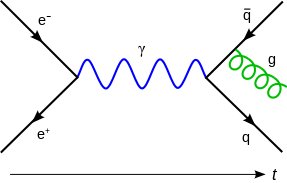Today in ISR I started doing some research on particle physics. The three topics I was focused on were Feynman diagrams, atomic and nuclear energy levels, and glueballs.
 Feynman diagrams are used to represent the mathematics explaining the behaviors of subatomic particles. The key with reading these diagrams is that normal particles are represented as moving forward in time while antimatter particles are represented as moving backwards in time. For example, the diagram to the left shows the collision of an electron and a positron which leads to the creation of a photon, a quark, an antiquark, and a gluon. One thing I do not understand is why it creates a photon that only lasts for a short period of time before becoming the quarks. Next ISR I hope to talk to Dr. Bill more about how to fully understand these diagrams
Feynman diagrams are used to represent the mathematics explaining the behaviors of subatomic particles. The key with reading these diagrams is that normal particles are represented as moving forward in time while antimatter particles are represented as moving backwards in time. For example, the diagram to the left shows the collision of an electron and a positron which leads to the creation of a photon, a quark, an antiquark, and a gluon. One thing I do not understand is why it creates a photon that only lasts for a short period of time before becoming the quarks. Next ISR I hope to talk to Dr. Bill more about how to fully understand these diagrams.
Glueballs are hypothetical particles made with no quarks. Instead, they are made just out of gluons, which are the elementary carrier particle for the strong nuclear force. I have been doing some research on them and I have come across some questions that I plan to research:
- Gluons have no rest mass, like photons, so doesn’t this mean that they are technically not matter? Or is this defined by whether or not an object has relativistic mass?
- Gluons do however make up a large portion of the mass of other particles. Since gluons have a large amount of binding energy using Einstein’s equation E=mc^2, this does technically equate to mass. However, do glueballs also have this large amount of binding energy?
- Scientists have done theoretical mathematical modeling of glueballs and found, contrary to their other predictions , decay into two quarks, most commonly strange quarks. However, how can a particle with no rest mass decay into quarks, which have rest mass?
Comments
admin
Sep 6, 2017
mass and energy move interchangeably, so matter has a varied definition...